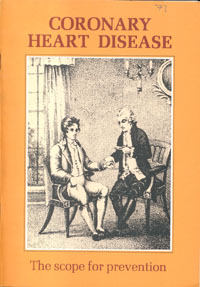Sign up to our newsletter Subscribe
Understanding societal preferences for priority by disease severity in England & Wales

One person in every four in England and Wales dies from coronary heart disease and at a minimum estimate the costs borne by the National Health Service in its treatment amount to £255 million. But of greater significance is the fact that it…
One person in every four in England and Wales dies from coronary heart disease and at a minimum estimate the costs borne by the National Health Service in its treatment amount to £255 million. But of greater significance is the fact that it is a major cause of premature morbidity and mortality. Surveys indicate that at least one man in two will show evidence of diseased coronary arteries by the age of65 years (Morris 1975) and that 38 per cent of the 7 3,ooo male deaths between 30 years and retirement age are attributable to this cause. Among men in the age range 45 to 54 this proportion rises to 41 per cent.
Coronary heart disease is the collective term given to various symptomatic manifestations which are the result of injurious processes occurring in the coronary arteries. The latter become narrowed with consequent impairment of blood flow and hence supply of oxygen to the heart’s muscle. These developments may give rise to a spectrum of events from angina through myocardial infarction to sudden death.
The disease processes involved have yet to be established. Epidemiological investigation has nevertheless uncovered a number of behavioural and other factors which appear to predispose to a greater likelihood of the development of symptomatic illness. Of these, cigarette smoking, elevated serum cholesterol levels and raised blood pressure have emerged as the most significant – together they can increase by eight-fold the chances of a ‘coronary event’. Estimates suggest that about 20 per cent of men and women aged 30- 49 have two or more concurrent major risk factors predictive for the disease (RCGP 1981b).
In spite of the aetiological uncertainties surrounding coronary heart disease the last decade has witnessed unprecedented advance in the potential for therapeutic intervention. Beta blocking drugs in conjunction with other medicines, now provide highly effective control of anginal pain in about three-quarters of patients. For more severe cases the development and refinement of coronary artery bypass surgery has facilitated relief for medically uncontrollable symptoms and in some instances substantially improved survival prospects. Before the 1970s there was little evidence to suggest that any specific therapeutic measure might be of value in reducing morbidity and mortality after myocardial infarction and many patients were simply subjected to prolonged periods of bed rest. Benefits in this area have since been shown to accompany the employment of aspirin, sulphinpyrazone, beta blocking drugs, thrombolytic agents such as streptokinase and a selective use of bypass surgery.
Continued thorough evaluation of these new therapeutic options should make it increasingly feasible to devise appropriate treatment strategies for most heart attack patients coming to care, with significant savings in terms of both lives and subsequent coronary episodes. It requires emphasis, however, that in coronary heart disease all measures currently available or under investigation are only effected once the disease process has become manifest and as such they are not ‘cures’ but means of symptomatic relief and, hopefully, secondary prevention.
In spite of such promising therapeutic developments, primary prevention therefore constitutes the optimal approach to the management of the disease. This observation is also founded on the substantial treatment and social costs of coronary heart disease, the fact that the benef1ts of potentially valuable new treatments have so far only been demonstrated in highly selected patient samples, the side effects and risks associated with all medical and surgical interventions and the finding that in some 20 per cent of cases of coronary heart disease there is no contact with physicians at all, the first recognised occurrence being sudden (and often premature) death (Rose 1981). Yet recent mortality and morbidity trends suggest that, in sharp contrast to other countries such as the United States, relatively little has been achieved in this field in spite of the initiatives of many agencies including the UK Departments of Health. Following a detailed review of the current understanding of the nature of coronary heart disease and its epidemiology, this paper examines the issues surrounding the problems of primary prevention and explores the possibilities for more successful interventions in the future.
Coronary Heart Disease: the Scope for Prevention
Wells, N.
(1982) Coronary Heart Disease: the Scope for Prevention. OHE Series on Health. Available from https://www.ohe.org/publications/coronary-heart-disease-scope-prevention/